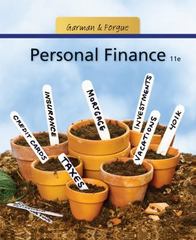Question
Suppose that market-index models for stocks A and B obey the following processes: RA = 1.2%+0.8RM +eA, (eA) = 8.35% RB = 1.1%+1.2RM +eB, (eB)
Suppose that market-index models for stocks A and B obey the following processes:
RA = 1.2%+0.8RM +eA, (eA) = 8.35%
RB = 1.1%+1.2RM +eB, (eB) = 7.65%
The market risk premium is 5.55%, the standard deviation of the market index is 16.20%, and the risk-free return is 2.25%
(a) Compute the expected return, risk premium, and standard deviation for RA.
(b) Compute the expected return, risk premium, and standard deviation for RB.
(c) Compute the covariance between RA and RB.
(d) Compute the expected return, risk premium, and standard deviation for a portfolio that allocates equally between A and B (i.e., wA = wB = 0.5).
(e) Compute the weights for the minimum-variance portfolio (that is fully invested in the two risky assets). Compute the expected return, risk premium, and standard deviation for the minimum-variance portfolio.
(f) Compute the weights for the portfolio with the maximum Sharpe ratio that is fully invested in the two risky assets (i.e., the tangency portfolio). Compute the expected return, risk premium, and standard deviation for the tangency portfolio.
(g) Suppose that a mean-variance investor has a risk-aversion index of 5. Compute the investors optimal allocations to the risk-free asset and tangency portfolio. What are the weights for A, B, and the risk-free asset for the optimal complete portfolio.
Step by Step Solution
There are 3 Steps involved in it
Step: 1

Get Instant Access to Expert-Tailored Solutions
See step-by-step solutions with expert insights and AI powered tools for academic success
Step: 2

Step: 3

Ace Your Homework with AI
Get the answers you need in no time with our AI-driven, step-by-step assistance
Get Started


